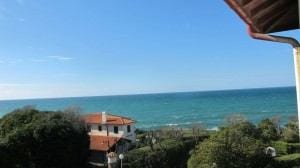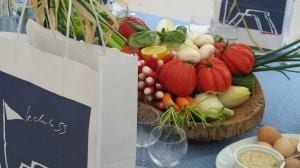Travel News
Fall in France: Three Coasts, Three Cultures, Three Cuisines
 It’s no secret that European travel gets better in the fall. Not only are hotels and airfares more affordable, but the crowds have died down and you can even score a restaurant reservation. And it turns out that some of the best culinary surprises can be found on the coast. Irvina Lew heads to France to report on the catch of the day from Paris to Saint Tropez.
It’s no secret that European travel gets better in the fall. Not only are hotels and airfares more affordable, but the crowds have died down and you can even score a restaurant reservation. And it turns out that some of the best culinary surprises can be found on the coast. Irvina Lew heads to France to report on the catch of the day from Paris to Saint Tropez.
When paired with gastronomy, learning geography is a delectable endeavor. France, where each coastline—the English Channel, the Atlantic Ocean and the Mediterranean Sea—influences both culture and cuisine illustrates the point.
On a recent journey from Paris to Deauville, in the north, to St. Jean de Luz, on the southwest coast and to St. Tropez, in the south, even entrees that showcase one fish, seabass, incorporate distinctly different ingredients and flavors of the region.
Normandy & The English Channel
The 360-mile coastline that borders the English Channel is full of green pastures with dairy farms and apple orchards. The area was settled by Vikings in the 9th century and local monuments reflect its long history: the 8th century Abbey of Mont-St-Michel perched precariously on a 264-foot high rock and separated from the mainland only by a causeway sometimes covered by tides, the twin towers of the 12th century Gothic cathedral in Rouen made memorable by Monet and the landing beaches where the invasion of Normandy took place on June 6, 1944.
Apple orchards are home to winery-like vats where juice is transformed into cider and Calvados, an apple brandy. Dairy farms produce sweet Isigny butter, creamy Camembert, Livarot, Pont l’Eveque and Brillat-Savarin cheese.
 In exclusive Deauville, which is famous for its racetrack, beachfront, Belle Epoque Casino Barriere de Deauville (which also houses a jewel of an opera house), grand mansions and what is claimed to be Chanel’s first boutique, local restaurants, such as Le Drakkar and Chez Miocque, serve the seafood specialite: Moules Frites, mussels a la Normandie, in a cream enhanced broth and served in big, black cast iron pots with a side of warmed bread, crisp fries and garlicky aioli.
In exclusive Deauville, which is famous for its racetrack, beachfront, Belle Epoque Casino Barriere de Deauville (which also houses a jewel of an opera house), grand mansions and what is claimed to be Chanel’s first boutique, local restaurants, such as Le Drakkar and Chez Miocque, serve the seafood specialite: Moules Frites, mussels a la Normandie, in a cream enhanced broth and served in big, black cast iron pots with a side of warmed bread, crisp fries and garlicky aioli.
In neighboring Trouville, individually owned stalls overflow with mussels, crabs and shrimp at the market and a friendly fishmonger introduced this American to a steamy bowl of freshly prepared soupe de poisson (a seafood stew) from an outdoor caldron.
At dinner, at 1899 within Le Manoirs de Tourgeville, a sprawling country inn located amidst horse farms and just outside the city center, the fish preparation was named for a nearby city in Normandy called Dieppe. Dieppoise Sea Bass dish incorporates typical local ingredients: shrimp, mussels, mushrooms and cider.
 Basque Country & the Atlantic
Basque Country & the Atlantic
In the southwest corner of France, on the Atlantic Coast, St Jean de Luz is a small, chic seaside resort just a few miles north of where France and Spain are separated by the Pyrenees and south of stunning Biarritz. This is Basque Country, Le Pays Basque, and its unique regional identity is more Basque than French or Spanish. The area has its own language, culture and, of course, gastronomy. Along with chocolate and cherries—which enhance cheese as well as cakes, tarts and jams, there’s the famous jambon (ham) from Bayonne. The most significant ingredient here is Espelette peppers. The green peppers are served stuffed with cod or seafood mousse and, in powdered form, the subtle spicy red ones are sold in jars to locals and tourists alike. Nuts are also famous in the region and are crushed to form a thin, crunchy and crusty coating on the seabass at La Reserve, a hillside hotel in St. Jean de Luz that overlooks the sea.
Provence & the Mediterranean
In sun-drenched Provence, on the Mediterranean coast, where the Roman occupation dates from 14 BC, rose wine is the drink of choice. There is such an abundance of beautiful vegetables along the Cote d’Azur that at some restaurants, including Club 55 on the beach in Ramatuelle, tables are decorated with paniers (baskets) full of multi-colored tomatoes, cucumbers, fennel, radishes and, of course, olives. At Hotel Byblos, in St. Tropez, Chef Vincent Maillard uses these typical Provencal ingredients —tomatoes, olives and basil—in his preparation for “Provencal Sea Bass.”
Saffron-infused bouillabaisse is the best-known and most loved regional fish soup. It’s made with a variety of fish, always live, local and the catch of the day, which in some places are brought to the table and introduced by name. Once cooked, the fish is returned separate from a bowl of broth and two garlicky side dishes–aioli and a spicy rouille—and crisp, toasted bread.
Coastal cuisine may differ, but it never fails to please, especially in France.
For more information on French travel and culinary adventures on and off the coast, check out:
- The Most Common Etiquette Mistakes Americans Make in France
- Foodie Round Up: The Complete Guide to Macarons in Paris
- St Remy Market, Provence France Video Postcard
- The Complete French travel archives
By Irvina Lew for PeterGreenberg.com. Irvina Lew is a writer who specializes in travel and spas. She is also the author of Romantic Weekends In and Around New York. Visit her online at IrvinaLew.com.













